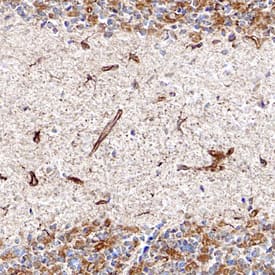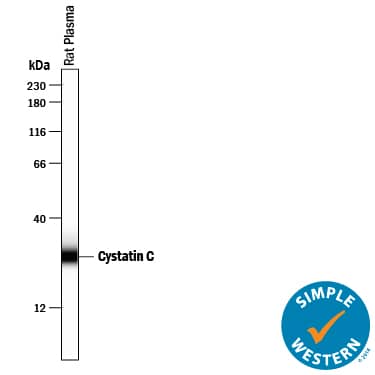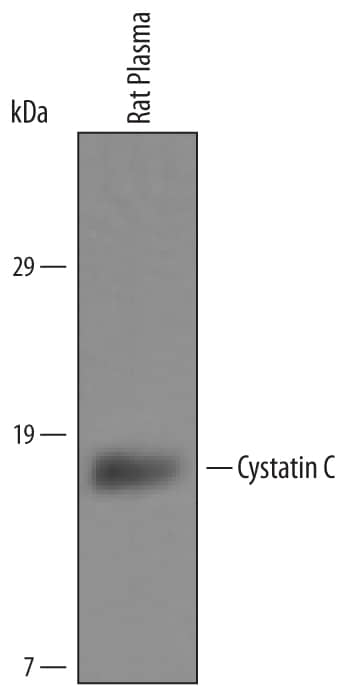Rat Cystatin C Antibody
R&D Systems, part of Bio-Techne | Catalog # AF6154

Key Product Details
Species Reactivity
Rat
Applications
Immunohistochemistry, Immunoprecipitation, Simple Western, Western Blot
Label
Unconjugated
Antibody Source
Polyclonal Sheep IgG
Product Specifications
Immunogen
Mouse myeloma cell line NS0-derived recombinant rat Cystatin C
Met1-Ala140
Accession # P14841
Met1-Ala140
Accession # P14841
Specificity
Detects rat Cystatin C in direct ELISAs and Western blots. In direct ELISAs, approximately 30% cross-reactivity with recombinant mouse Cystatin C and approximately 15% cross-reactivity with recombinant human Cystatin C is observed.
Clonality
Polyclonal
Host
Sheep
Isotype
IgG
Scientific Data Images for Rat Cystatin C Antibody
Detection of Rat Cystatin C by Western Blot.
Western blot shows rat plasma. PVDF Membrane was probed with 1 µg/mL of Sheep Anti-Rat Cystatin C Antigen Affinity-purified Polyclonal Antibody (Catalog # AF6154) followed by HRP-conjugated Anti-Sheep IgG Secondary Antibody (HAF016). A specific band was detected for Cystatin C at approximately 16 kDa (as indicated). This experiment was conducted under reducing conditions and using Immunoblot Buffer Group 8.Cystatin C in Rat Brain.
Cystatin C was detected in perfusion fixed frozen sections of rat brain (cerebellum) using Sheep Anti-Rat Cystatin C Antigen Affinity-purified Polyclonal Antibody (Catalog # AF6154) at 1.7 µg/mL overnight at 4 °C. Tissue was stained using the Anti-Sheep HRP-DAB Cell & Tissue Staining Kit (brown; CTS019) and counterstained with hematoxylin (blue). Specific staining was localized to neurons in the molecular layer of the cerebellum. View our protocol for Chromogenic IHC Staining of Frozen Tissue Sections.Detection of Rat Cystatin C by Simple WesternTM.
Simple Western lane view shows rat plasma, loaded at 0.2 mg/mL. A specific band was detected for Cystatin C at approximately 28 kDa (as indicated) using 10 µg/mL of Sheep Anti-Rat Cystatin C Antigen Affinity-purified Polyclonal Antibody (Catalog # AF6154) followed by 1:50 dilution of HRP-conjugated Anti-Sheep IgG Secondary Antibody (HAF016). This experiment was conducted under reducing conditions and using the 12-230 kDa separation system.Applications for Rat Cystatin C Antibody
Application
Recommended Usage
Immunohistochemistry
5-15 µg/mL
Sample: Perfusion fixed frozen sections of rat brain (cerebellum)
Sample: Perfusion fixed frozen sections of rat brain (cerebellum)
Immunoprecipitation
25 µg/mL
Sample: Conditioned cell culture medium spiked with Recombinant Rat Cystatin C (Catalog # 6154-PI), see our available Western blot detection antibodies
Sample: Conditioned cell culture medium spiked with Recombinant Rat Cystatin C (Catalog # 6154-PI), see our available Western blot detection antibodies
Simple Western
10 µg/mL
Sample: Rat plasma
Sample: Rat plasma
Western Blot
1 µg/mL
Sample: Rat plasma
Sample: Rat plasma
Formulation, Preparation, and Storage
Purification
Antigen Affinity-purified
Reconstitution
Reconstitute at 0.2 mg/mL in sterile PBS. For liquid material, refer to CoA for concentration.
Formulation
Lyophilized from a 0.2 μm filtered solution in PBS with Trehalose. *Small pack size (SP) is supplied either lyophilized or as a 0.2 µm filtered solution in PBS.
Shipping
Lyophilized product is shipped at ambient temperature. Liquid small pack size (-SP) is shipped with polar packs. Upon receipt, store immediately at the temperature recommended below.
Stability & Storage
Use a manual defrost freezer and avoid repeated freeze-thaw cycles.
- 12 months from date of receipt, -20 to -70 °C as supplied.
- 1 month, 2 to 8 °C under sterile conditions after reconstitution.
- 6 months, -20 to -70 °C under sterile conditions after reconstitution.
Background: Cystatin C
References
- Reed, C.H. (2000) British J. Biomed. Sci. 57:323.
- Janowski, R. et al. (2001) Nat. Struct. Biol. 8:316.
- Abrahamson, M. (1994) Methods Enzymol. 244:685.
- Abrahamson, M. et al. (1992) Hum. Genet. 89:377.
- Laterza, O.F. et al. (2002) Clin. Chem. 48:699.
Alternate Names
ARMD11, CST3, Gamma-trace, Neuroendocrine basic polypeptide, Post-gamma-globulin
Gene Symbol
CST3
UniProt
Additional Cystatin C Products
Product Documents for Rat Cystatin C Antibody
Product Specific Notices for Rat Cystatin C Antibody
For research use only
